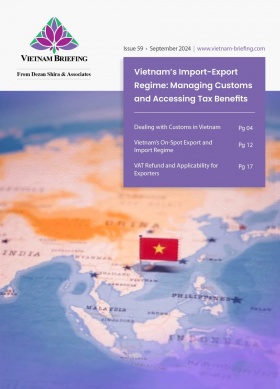Evolving Landscape of Vietnam’s Snack Market: Ample Opportunities for Businesses
Vietnam’s snack market is undergoing rapid evolution, leading to an increased demand for convenient and diverse snack options. As more consumers, especially in major cities, lean toward healthy and premium snacks, both local and international brands are discovering ample opportunities in this vibrant and dynamic market.
Vietnam’s snack food market is experiencing rapid expansion, fueled by shifting consumer preferences, rising incomes, and urbanization. Valued at US$3.2 billion in 2023, the market is driven by the increasing demand for convenient and affordable food options, a growing middle-class population, and changing dietary patterns.
The country’s economic growth has led to higher disposable incomes, allowing consumers to spend more on premium and diverse snack products. In the first half of 2024, the average monthly income of Vietnamese workers reached VND7.5 million (approx. US$300), marking a 7.4 percent increase compared to the same period in 2023. This financial boost is directly influencing consumption patterns, as more consumers opt for premium snack options, particularly in major cities like Hanoi, Ho Chi Minh City, and Da Nang.
Simultaneously, urbanization is reshaping Vietnam’s economic landscape. While still at a lower level compared to neighboring Asian countries, Vietnam’s urban population is steadily increasing. Projections suggest that by 2040, over half of the country’s population will reside in urban areas, reaching 57.3 percent by 2050. This shift is driving greater demand for convenient, ready-to-eat snacks, particularly among time-strapped urban dwellers.
Within the market, savory snacks dominate, especially among younger consumers who frequently snack between meals. However, in rural areas, affordability remains the primary concern, with mass-market products retaining strong demand.
As Vietnam continues to integrate Western food culture while maintaining traditional flavors, the snack industry is poised for sustained growth, presenting significant opportunities for both local and international brands.
Snack preferences of Vietnamese people
Traditional tastes vary accross Vietnam
Vietnam’s diverse culinary culture plays a central role in its snack market, with regional preferences shaping the types of snacks consumed.
- Northern Vietnam: Snacks tend to be light and subtly flavored, reflecting deep-rooted culinary traditions. Popular offerings include various traditional treats, such as bánh giò (rice flour dumplings filled with pork and mushrooms), bánh rán (deep-fried glutinous rice balls with mung bean paste), and xôi (sticky rice with various toppings).
- Central Vietnam: Snacks are known for their bold, spice-infused flavors. Regional favorites such as bánh bèo (steamed rice cakes with shrimp powder and crispy pork skin) and bánh tráng nướng (grilled rice paper with eggs, meat, and scallions) offer complex and satisfying taste profiles.
- Southern Vietnam: Influenced by the area’s warm climate, people favor sweeter snacks made from tropical ingredients. Bánh tráng trộn, a mix of shredded rice paper with tamarind sauce and dried beef, is a popular treat among the youth in HCMC, alongside various kinds of sweets containing coconut ingredients.
Influence from the modern lifestyle
While traditional snacks remain crucial to Vietnam’s culinary identity, the influence of imported brands from Korea, Japan, and Western countries is growing. Younger consumers, increasingly influenced by social media and global food trends, are embracing products such as potato chips, chocolate bars, and dairy-based snacks. This shift has prompted international companies to increase their presence in Vietnam, with platforms like TikTok, Facebook, and Instagram driving food trends and helping local entrepreneurs launch innovative snack ideas.
Indeed, social media has become a key player in shaping snack trends, particularly among younger consumers. Reports indicate that 70 percent of Vietnamese consumers actively engage with snack trends, making the country one of Asia’s fastest-growing snack markets. For instance, beverages like trà mãng cầu (custard-apple tea) and trà sữa khoai môn tươi (milk tea with fresh taro sauce) gained popularity thanks to social media exposure. This dynamic environment has fostered a thriving market for innovative snack concepts, with numerous small businesses thriving through online platforms.
Key players in Vietnam’s snack market
Most notable brands
Vietnam’s snack industry is shaped by a mix of local and international brands, each catering to evolving consumer preferences. Mondelez International dominates the market with its Oreo and Kinh Do brands, appealing to both premium and mass-market segments. PepsiCo holds a strong position in the savory snack category through Lay’s and Poca, while the South Korean Orion Group continues to capture demand with its popular Choco Pie. Kinh Do Corporation remains one of Vietnam’s most established domestic brands, offering a blend of traditional and contemporary snack options. Meanwhile, URC Vietnam has solidified its market presence with its widely recognized Jack ‘n Jill products.
PepsiCo is further strengthening its footprint in Vietnam through significant investments, including a US$90 million food processing facility in Ha Nam and a US$300 million beverage plant in Long An. These facilities, designed to operate on renewable energy sources, align with the company’s sustainability objectives. The Ha Nam factory alone is expected to produce over 23,000 tonnes of snack products annually, supplying both the Vietnamese and Cambodian markets while generating more than 1,000 local jobs and contributing to regional economic growth.
Exports of Vietnam’s snacks
Vietnamese snack products are also gaining international recognition, reflecting the country’s expanding presence in the global food market. A notable example is Ben Tre’s coconut candy, which was recently ranked 26th among the world’s top 70 sweets by Taste Atlas. Traditionally made from grated coconut, coconut milk, and sugar, this confection has evolved to incorporate innovative flavors such as pandan, durian, and roasted peanuts, further enhancing its appeal among global consumers.
Premium snacks
Looking ahead, the premium snack segment presents significant growth opportunities. Vietnam is home to approximately 50 instant noodle producers, with Acecook Vietnam, Masan Consumer, Uniben, and Asia Foods leading the industry. Acecook solidified its dominance in 2022 with over US$590 million in revenue, while Masan’s convenience food segment, including instant noodles, recorded a 7.8 percent year-on-year growth rate in the first half of 2023. As competition intensifies, companies are increasingly focusing on product differentiation and health-conscious innovations to meet shifting consumer demands.
Future prospects
The Vietnamese snack market is undergoing a notable transformation, shifting beyond traditional considerations of taste and convenience toward a stronger emphasis on health-conscious and functional foods. Rising consumer awareness of nutritional benefits is driving demand for products that offer both indulgence and added health value.
Health-driven snacking is in demand
Health-driven snacking is becoming a key trend, with a growing preference for nutrient-rich and functional food options. In the bakery segment, while freshness and taste remain primary factors, a significant 51 percent of Vietnamese consumers now prioritize health attributes, compared to a global average of 32 percent. This shift is influencing purchasing decisions, particularly for products with reduced sugar content and claims emphasizing high fiber or protein content.
Similarly, the dairy sector is experiencing increased demand for low-fat cheese and fortified milk drinks as product safety and functional ingredients become top considerations. Additionally, the consumption of seafood, meat, and poultry is largely driven by perceptions of freshness, affordability, and nutritional benefits, with a particular emphasis on omega-3 fatty acids and high-protein content.
The demand for gluten-free, keto, and low-sugar options has surged, particularly after the pandemic. Around 86 percent of Vietnamese consumers prioritize portion control and ingredient transparency, with many seeking snacks that offer both nutritional value and indulgence. This has led to the rise of functional snacks—products that offer additional benefits beyond just taste, such as improved energy or better gut health.
Premium, functional snacks are gaining popularity
The market for premium and functional snacks is also expanding, reflecting consumers’ increasing interest in high-protein, fiber-rich products, such as cereals and energy bars. Natural and functional ingredients are becoming key differentiators, aligning with broader health-conscious trends. Moreover, Vietnam is witnessing notable growth in plant-based and sports nutrition segments, with the adoption of meat substitutes outpacing the global average (25 percent vs. 20 percent), highlighting a gradual but steady transition toward alternative protein sources.
Market transformations driven by digital and social media trends
Digital and social media trends continue to shape the market, with online platforms playing a crucial role in influencing consumer behavior. Viral food trends continue to drive sales, particularly for visually appealing and trend-driven snacks popularized on platforms such as TikTok and Instagram. At the same time, the expansion of e-commerce is reshaping distribution channels, as brands increasingly leverage direct-to-consumer sales and digital marketing strategies to engage younger, tech-savvy consumers.
Takeaways
Vietnam’s snack market is poised for significant growth, valued at US$3.2 billion in 2023, driven by rising disposable incomes, urbanization, and changing consumer preferences. The expanding middle class is increasingly opting for premium snack products, especially in urban centers. Strong regional diversity in snack choices presents both challenges and opportunities for brands.
Key players like Mondelez, PepsiCo, and local brands like Kinh Do are expanding their presence, indicating robust market competition. Social media is influencing snack trends, particularly among younger consumers, creating a fertile ground for innovative products. Investing in Vietnam’s snack market presents promising prospects, leveraging its blend of traditional and modern influences.
About Us
Vietnam Briefing is published by Asia Briefing, a subsidiary of Dezan Shira & Associates. We produce material for foreign investors throughout Asia, including ASEAN, China, and India. For editorial matters, contact us here and for a complimentary subscription to our products, please click here. For assistance with investments into Vietnam, please contact us at vietnam@dezshira.com or visit us at www.dezshira.com.
Dezan Shira & Associates assists foreign investors throughout Asia from offices across the world, including in Hanoi, Ho Chi Minh City, and Da Nang. We also maintain offices or have alliance partners assisting foreign investors in China, Hong Kong SAR, Dubai (UAE), Indonesia, Singapore, Philippines, Malaysia, Thailand, Bangladesh, Italy, Germany, the United States, and Australia.
- Previous Article The Impact of Tariffs on Vietnamese Exports: US-Vietnam Trade Relations Under Trump 2.0
- Next Article Vietnam-US Trade and Investment Relations: Q1 2025 Update






























